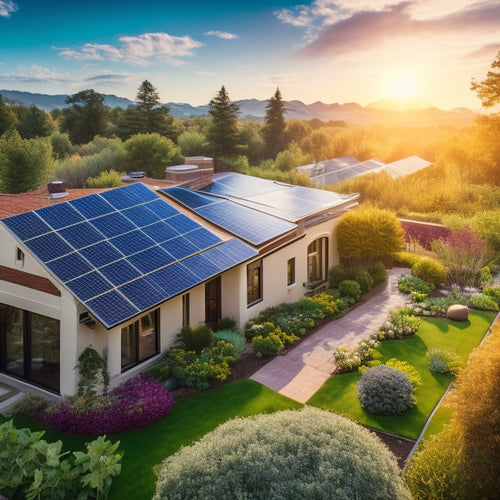
Calculating Solar Installation Costs for Your Home: 3 Methods
Share
To calculate the total cost of a solar installation for your home, you'll need to take into account three key factors. First, assess your energy needs by evaluating your energy consumption patterns, analyzing past electricity bills, and determining your average daily energy usage. Next, understand the costs of system components, including solar panels, inverters, and mounting hardware, which vary in price depending on the complexity of the installation and local labor rates. Finally, factor in incentives and rebates, such as the federal Solar Investment Tax Credit and state and utility rebate programs, which can greatly reduce upfront costs, and uncover how you can maximize your savings.
Key Takeaways
- Evaluate energy consumption patterns to identify waste reduction opportunities and determine average daily energy consumption in kWh.
- Identify primary solar system component costs, including solar panels, inverters, mounting hardware, and BOS components, to calculate total installation costs.
- Consider financial benefits like the Federal Solar Investment Tax Credit, state tax credits, and utility rebate programs to reduce upfront installation costs.
- Analyze system size and configuration requirements to ensure maximum efficiency and reliability, factoring in peak usage times and seasonal variations.
- Calculate labor costs influenced by complexity, roof type, and local labor rates to get an accurate total installation cost estimate.
Assessing Your Energy Needs
Typically, homeowners assessing solar installation start by evaluating their energy needs, as this essential step lays the groundwork for determining the ideal system size and configuration.
You'll want to assess your energy consumption patterns to identify areas where you can enhance energy usage and reduce waste. This involves analyzing your past electricity bills to determine your average daily energy consumption in kilowatt-hours (kWh).
You'll also need to take into account your energy usage patterns, such as peak usage times and seasonal variations.
Understanding your energy needs is fundamental for achieving maximum solar efficiency. A well-designed solar system should be capable of meeting your energy demands while maximizing energy production.
By evaluating your energy needs, you can determine the required system size and configuration to guarantee you're generating enough power to meet your requirements.
This, in turn, will help you improve your solar installation costs and assure a reliable, efficient, and cost-effective system.
Understanding System Component Costs
With your energy needs assessment complete, you can now focus on the components that will make up your solar installation. These components are the building blocks of your system, and their costs vary depending on the type and quality you choose. The primary component types include solar panels, inverters, mounting hardware, and balance-of-system (BOS) components like wiring and electrical connections.
Solar panels are the most visible component, and their cost is typically the largest portion of the overall installation cost. Inverters convert the DC power from the solar panels to AC power for your home, and their cost is usually the second-largest component.
Mounting hardware, including racking and tracking systems, secures the solar panels to your roof or ground. BOS components like wiring and electrical connections complete the system.
Installation labor is another significant cost factor. The complexity of your installation, including roof type, size, and pitch, will affect labor costs. Additionally, local labor rates and installation company overhead will also impact the final cost.
Understanding these component types and installation labor costs will help you make informed decisions when selecting a solar installation provider and negotiating the final cost of your system.
Factoring Incentives and Rebates
Your solar installation cost calculation wouldn't be complete without considering the financial benefits that can greatly reduce your upfront expenditure. Incentive programs and rebates can considerably impact your overall cost, making solar energy more accessible and affordable.
To maximize your savings, you'll need to determine your rebate eligibility and factor these benefits into your calculation.
Here's a breakdown of some common incentives and rebates:
| Incentive/Rebate | Description | Potential Savings |
| Federal Solar Investment Tax Credit (ITC) | 26% of total system cost | Up to 26% of total system cost |
| State Tax Credits | Varies by state | Up to $1,000 or more |
| Utility Rebate Programs | Varies by utility company | Up to $1,000 or more |
Keep in mind that these incentives and rebates may have specific requirements and limitations, so be sure to research and review the terms and conditions carefully.
Frequently Asked Questions
What Are the Benefits of Hiring a Professional Solar Installer?
When you hire a professional solar installer, you'll benefit from their installation knowledge, ensuring a smooth process and ideal system performance, which leads to cost savings and increased energy output, giving you the power you need.
How Long Does a Typical Solar Installation Project Take?
You'll typically spend 2-3 months on a solar installation project, broken down into project phases: assessment, design, permitting, installation, and inspection, with the actual installation timeline lasting around 1-3 weeks, depending on the complexity of your system.
Can I Install Solar Panels on My Own?
You can attempt a DIY solar installation, but you'll face installation challenges like roof assessments, electrical connections, and permits, which can be time-consuming and risky if not done correctly, potentially voiding your warranty.
Are Solar Panels Durable and Long-Lasting?
You're likely wondering if solar panels can withstand the elements; research suggests they can, with a typical solar panel lifespan of 25-30 years, requiring minimal maintenance, and performing efficiently with occasional cleaning and inspections.
Will Solar Panels Increase My Property Value?
You'll likely raise your property value by installing solar panels, as they're seen as a desirable feature that enhances energy efficiency, making your home more attractive to potential buyers and potentially elevating its resale value.
Conclusion
As you wrap up calculating solar installation costs for your home, remember that every dollar counts. Did you know that the average American family saves around $500 per year on their electricity bill by going solar? By evaluating your energy needs, understanding system component costs, and factoring in incentives and rebates, you'll be well on your way to utilizing the power of the sun and reaping the financial benefits. Now, get ready to bask in the savings!
Related Posts
-

Sustainable Solar Energy for Cost-Effective Living
Adopting sustainable solar energy isn't just eco-friendly; it's a smart financial strategy. You'll slash your monthly...
-

Solar Power Backup Solutions During Outages
Solar power backup solutions guarantee you have reliable energy during outages, providing essential power when the gr...
-

High-Performance Energy-Efficient HVAC Systems
High-performance energy-efficient HVAC systems are essential for reducing energy consumption while improving indoor c...


